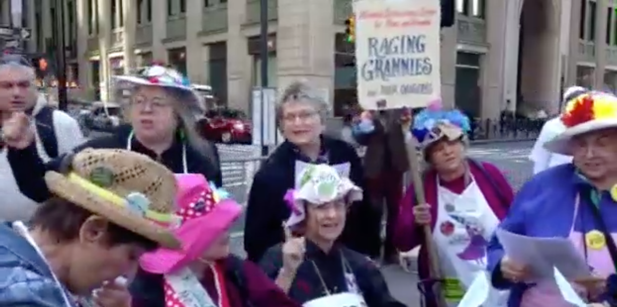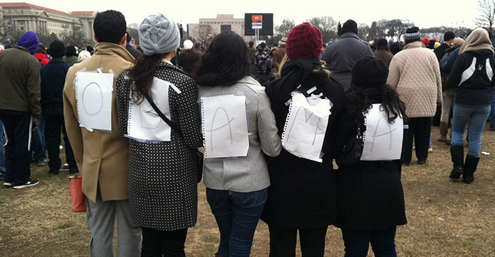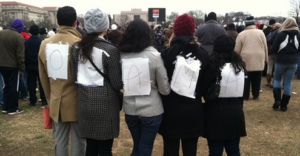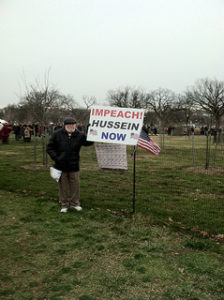by Timothy Weisberg | Oct 27, 2013 | Published Work
Published for Southern Stories: Today’s Alabama, A special report from NYU’s Pavement Pieces
Elihue Claiborne will have healthcare for the first time at the age of 43. He was one of over 600,000 uninsured Alabama residents until a faith-based advocacy group in Birmingham stepped in and helped him get coverage.
“I qualified for it and I’m glad I came to get the program,” said Claiborne. “Then I came for my mom and got her signed up.”
Claiborne learned he and his mother now qualified for health insurance under the Affordable Care Act at Greater Birmingham Ministries, which offers community services such as food and clothing drives for Birmingham’s impoverished as well as education sessions on issues ranging from healthcare, obtaining WIC and food stamps, how to obtain Alabama state identification, register to vote as well as keeping them up to date on policy changes.
Claiborne’s mother, who is in her late 60s was diagnosed with terminally ill cancer and could not afford to get treatment. Now, he is hopeful that both he and his mother will have greater access to the health care providers and medication they need.
“It’s a blessing,” he said. “It’s really a blessing.”
The Affordable Care Act mandated that people living below 138 percent of the federal poverty line, about $27,000 for a family of three, could now receive Medicaid regardless of preexisting health conditions. But experts say old structural issues remain in the way of providing quality care for the nation’s impoverished. For those who do fall under expansion guidelines, access to healthcare providers who accept Medicaid is still a major issue in Alabama and states throughout the nation. But many may still not receive coverage at all, with states choosing not to expand their services.
In a June 2012 ruling, the Supreme Court gave states the option to opt out of the ACA’s Medicaid expansion. Currently, 15 states have chosen to opt out, leaving over 5 million people in a coverage gap, where they cannot have access to Medicaid or qualify for coverage or tax credits under the federal health exchange.
“I’m not sure if the federal government knows what to do with this population, because this law is written in a way that it puts them in a tricky spot that they’re ineligible for subsidies,” University of Alabama at Birmingham (UAB) Associate Professor of Public Health David J. Becker said.
Becker said the state’s decision not to expand Medicaid creates a “donut-hole” in health care coverage for those who need it most.
“Last time I checked if you’re thinking about a real comprehensive health care bill that’s going to change the nature of the U.S. health care system, you would think there would be something for the poorest Americans,” he said. “And currently there is not.”
Nationally, the coverage gap represents over a quarter of the uninsured population in states not expanding Medicaid, according to a study by the Kaiser Foundation. In Alabama, that percentage is as high as 36 percent, the second highest in the nation.
“You’ve got a lot of people that just fall into that gap in Alabama that work, but they might not be getting enough as far as salary goes to qualify,” said Stan Johnson, an independent contractor with the non-profit Alabama Arise. “We have a lot of people who are trying, but they just don’t make enough.”
While organizations like Alabama Arise and Greater Birmingham Ministries have started education and enrollment campaigns, they continue to have to turn people who would otherwise qualify under Medicaid expansion away.
“I think we’ll see people that are lost by the wayside, folks who are going to fall through the cracks,” said Mary Jones, co-coordinator of Direct Services at GBM.
“The people that come here are like myself, who are not able to get the medication that is required for their illness, they go without it,” she said. “I go without medication.”
According to a 2012 study co-authored by Becker on the economic effect Medicaid expansion would have in Alabama, expansion would reduce the state’s uninsured population by approximately 232,000 individuals while generating $20 billion in new economic activity and a $935 million increase in net state tax revenues. But in spite of these reported benefits, Becker said many Republican state legislatures remain skeptical of how much the bill would cost states in the future.
Under the ACA, the federal government covers all Medicaid expansion costs from 2014 through 2016. States would still be responsible for some administrative costs, but the federal government would almost entirely foot the bill for the first three years of implementation. Federal government funding would decrease on a sliding scale after 2016 to 90 percent of all costs by 2020, according to Becker’s study.
“There’s some uncertainty [in states] if the federal government shirks its responsibility then what are we left to do?” Becker said. “Are we going to be able to withdraw from this program or not?”
Even if Alabama chose to expand Medicaid, local clinics said the newly insured would still lack access to medical services.
“If Medicaid expands in our community, that’s not a silver bullet to poverty,” Executive Director of M-Power Ministries Ryan Hankins said. “There are simply not enough Medicaid providers to serve the population.”
Chris Monceret, Executive Director of the Community of Hope Health Clinic in nearby Pelham, Ala., echoed Hankins’ sentiments about access, regardless of whether people receive Medicaid under ACA.
“If you have someone in rural Shelby County, and their only medical provider is 70 miles away, and they don’t have transportation, then essentially they don’t have an insurance provider,” she said.
“We’re going from no health insurance and no access, to some health insurance with still no access,” said Laura Washington, health center director at M-Power Ministries.
The clinic serves uninsured patients at 200 percent or above the federal poverty line, and thus most would qualify under Medicaid expansion, said Hankins.
“We find ourselves on the one hand being pushed to advertise and market these services to the population knowing that very few of them actually qualify for the exchange,” he said.
Hankins added health care was a means to an end, with the goal of ultimately curtailing “generational poverty.”
“The population that we serve come to us with health concerns, but those are often masked or masked by educational deficits, employment deficits, etc.,” he said, noting that many patients are wary of getting treatment from traditional medical personnel.
Becker said the issue of access was inherent in the way the healthcare system was structured before the ACA.
“The question is what do we want Medicaid to be like, what level of care are we providing to those that can’t provide for themselves?” he said. “We didn’t have a coherent discussion about willingness to pay.”
Even for those uninsured who are eligible for coverage under the online health exchange, Healthcare.gov has been riddled with delays and technical glitches, distracting the public from what Becker says is the bigger issue in providing healthcare.
“I think it would be much better if Americans were aware of this gap population rather than whether a web site is functioning properly” he said, adding that many people now have a misconception that the ACA is providing insurance for the poor.
For Claiborne, who says he is fortunate that he qualified for coverage under ACA, there are many people he has encountered at GBM who were turned away because they did not make enough.
“It’s not right,” he said. “It’s not right at all. Everybody’s got a falling point in their life.”
For a population that has been historically underserved, Hankins said the complexities of healthcare reform are confounding an already complex set of issues.
“It’s really a perfect storm of an under resourced community serving an under informed population with additional confusion at all levels of the healthcare system,” he said.

by Timothy Weisberg | Sep 17, 2013 | Published Work
Story on anniversary of Occupy Wall Street movement for NBC New York
Occupy Wall Street activists rallied in lower Manhattan’s Zuccotti Park on Tuesday to mark two years since their movement began there. Among them: One small group of singing, cane-wielding women who dub themselves the Raging Grannies.
The group’s members, mostly over 65 and retired, may not be as visible as the debt-saddled college graduates and unemployed people at the movement’s forefront. But on Tuesday, they were among the most vocal.
“Good news! Occupy Wall Street’s a-coming! And you don’t want to leave us behind,” they sang.
While other groups marched and banged drums, lambasting stop-and-frisk and calling for higher wages for fast-food workers, the Raging Grannies sang parodies about social and economic inequalities.
Founded in British Columbia in 1987, the Raging Grannies is a loose-knit group of mostly senior women that promotes equality, according to its website. Members of its chapters, or “gaggles,” range in age from 49 to 98.
“We really need to turn a lot of things around, especially the wealth gap in the city,” said Raging Grannies member and retired nurse practitioner Alice Sturmsutter.
The group admits that the Occupy movement has struggled to find a direction since police cleared the encampment in Zuccotti Park in 2011. On Tuesday, only a few hundred protestors were in attendance at the park, once packed with thousands at the height of the movement.
“They had set up some wonderful things in Zuccotti Park, and that was all destroyed,” said Raging Grannies member Corinne Willinger. The raid, she said, “changed the whole complexion” of the movement.
Willinger’s group hopes to change that. Despite the movement’s splintering, the Raging Grannies have praised Occupy for its community engagement and grassroots efforts, particularly for its disaster relief campaigns after Sandy.
“Occupy has been very welcoming,” said Sturmsutter, who worked a health tent during the occupation of Zuccotti Park in 2011. “It’s a sense of community, and it’s a sense of creating a better world and bringing about justice.”
And for the Raging Grannies, there’s more to the movement than commemorating its beginnings.
“I hope for some action in between, too,” Sturmsutter said. “I hope it won’t just be anniversaries.”

by Timothy Weisberg | Jan 21, 2013 | Published Work
Published as part of 2013 Presidential Inauguration coverage by NYU’s Pavement Pieces
WASHINGTON,D.C–Despite the decreased hype following Obama’s rise to the Presidency in 2009, President Obama’s message remains just as powerful: the nation must remain optimistic.
While history has a tendency to repeat itself, this is not Obama’s first rodeo. Over 800,000 people were in attendance at the 2013 Presidential inauguration, which marked the beginning of President Obama’s second term, a significant decrease from the 1.8 million that attended Obama’s first inauguration in 2009.

Francisca Fernando, 24, far right, and Katy Burk, 25, second from right, watching the 2013 Presidential Inauguration from a Jumbotron at the National Mall in Washington, D.C.. (Photo by Timothy Weisberg.)
In the midst of a deep partisan divide in Congress, wars in Afghanistan and Iraq, and the worst economic crisis since the Great Depression, Obama’s message of hope and promise for the country remain in tact.
“It’s a different feeling this time around,” said Katy Burke, 25, of Washington, D.C.
Abui Tamakloe, 35, of Brooklyn, echoed Burke’s sentiments, noting that Obama’s second term placed less of an emphasis on what was then “history in the making:” the first black President of the United States.
“The fact he got re-elected means that people actually believe in him,” she said. “And it’s not just about the color of his skin, but also what the person stands for.”
Messages of patience and compromise to push the nation’s problems behind could not have been conveyed any better to the thousands that gathered in the non-ticketed area of the National Mall next to the Washington Monument.
A Jumbotron airing the inauguration experienced extensive technical difficulties, often with scratchy video and out of sync audio even as Obama was sworn into oath and James Taylor performed “America The Beautiful.”
“Can we watch the inauguration please?” one woman exclaimed impatiently. “This is really going well,” another man said sarcastically as he left National Mall.
Some booed and many left, but others laughed it off, knowing their presence alone was enough to understand why hundreds of thousands were in attendance. Hopefulness and assurance have embodied Obama supporters during four years of a sinking economy, high unemployment, and a rising gap between the rich and poor.
“For me it did not matter because it’s a solemn occasion,” Tamakloe said. “I know why I am here.”
However, one of the few protesters at the National Mall during the inauguration, Dr. William Escoffery of Fort Walton Beach, Fla., believed the technical mishap epitomized Obama’s Presidency.

Dr. William Escoffery of Fort Walton Beach, Fla. protests the 2013 Presidential Inauguration. Escoffery, 68, believes people do not realize the problems Obama has created for the country over the past four years. (Photo by Timothy Weisberg)
“I think this is a paradigm for what he’s done to the country,” Escoffery, 68, said. “You can’t even hear what he’s saying on the screen and all of his supporters are leaving because they can’t hear what he’s saying.”
Holding a sign that read “Impeach! Hussein Now,” the Jamaica native found it alarming that such a high percentage of African-Americans were in support of Obama, adding that many African-Americans voted for Obama solely based on his ethnicity.
“(Jamaicans) are not hung up on black or white,” he said. “We look at the core embodiment of what a person’s doing for their country.”
And like his previous term, Obama faces many obstacles and battles ahead, where even supporters have mentioned that he has unfinished business.
With the Congressional gridlock over solving the fiscal cliff crisis, which would have prompted over $500 billion in tax increases and across-the-board-spending cuts beginning Jan. 1, only a few weeks old, another battle in Congress over the nation’s borrowing limit is under way. Issues over the debt ceiling and the country’s ability to pay back its obligations remain a core problem for a recovering economy.
“The first four years the economy was in a shambolic situation,” said Francisca Fernando, 24, of Washington, D.C. “You almost (consider) it acceptable, but now is the time for him to really make some changes and for us to see the impact of the policies he set in place.”
The President has also faced his fair share of criticism, including the handling of attacks on the U.S. Consulate in Benghazi Sept. 11, 2011, in which U.S. Ambassador to Libya J. Christopher Stevens and three others were killed.
And while he has made significant achievements in healthcare reform and a systematic overhaul of Wall Street, opponents point to his lack of an agenda for much needed economic recovery. The United States is also a nation in which the unemployment rate did not drop below eight percent until Sept. 2011, nearly three years since President Obama took office in January 2009.
The shootings at a Connecticut elementary school last month also make gun control a core issue for his second term, along with major changes to the nation’s immigration policies, the implementation of Obamacare, and other means by which to boost a stagnant economy, an agenda that will inevitably ignite a heated battle between Obama and House Republicans.
Yet according to a CNN poll conducted in Nov. 2011 and released Sunday, 54 percent of Americans were optimistic Obama would perform well in his second term.
Obama also mentioned the rights of gay Americans and pledged to solve the increasing problems of climate change.
“Our journey is not complete until our gay brothers and sisters are treated like anyone else under the law,” Obama said during his inaugural address, to rambunctious cheers from the crowd.
For people like Fernando, the hope is that Obama will be able to overcome the partisan riff that exists in Congress and push through important policies that will alleviate many of the budgetary and spending problems the nation will inherently undertake during Obama’s second term.
“He’s been given a second chance and I think people are really hoping that some changes happen,” she said.

by Timothy Weisberg | Jan 24, 2011 | Published Work
Story I wrote that was published in the Ithaca Journal.
Sometimes a role reversal is what it takes to come away victorious, a gamble when it appears you might just be bluffing.
But for Charlie Kern, 41, of Elhurst, Ill., it was a change in technique and a gamble that ultimately paid off for him in winning the elite masters men’s 40s race in 4 minutes, 21 seconds Saturday at the 44th annual Hartshorne Masters Mile at Cornell University’s Barton Hall.
Kern beat out Nicholas Berra, 41, of Enola, Pa. on the final lap, as he was able to get ahead on the final stretch and pull away. Berra finished second with a time of 4:23.0, followed by Lance Elliott, 40, of Edina, Minn. with a time of 4:31.
Kern said his approach was unorthodox.
“I have been in a number of races where I have led from the start and I didn’t want to do that (Saturday),” he said. “I wanted to be in an attack position as opposed to a hunted position.”
It was Kern’s first time running in the annual Masters Mile, and first time running in Barton Hall since 1987, his senior year in high school when he ran in the New York state championships.
Berra led for the majority of the race before Kern out-kicked him on the final lap and stretched ahead for good.
For race director Tom Hartshorne, the elite men’s 40s race was a race for the ages, but might have resulted in a different outcome had Kern stuck to his traditional method of leading the pack.
“I think it might have been a different race if Berra had sat on (Kern’s) shoulder and hung with him,” Hartshorne said. “But it was a great race.”
According to Hartshorne, Kern typically likes to control the race and is a traditional mile-runner, while Berra, an 800-yard competitor, is usually the one trailing looking for an opportunity to break from the leader’s shoulder.
“The race in my mind was Charlie trying to break him with three laps to go and Nick trying to hang on so he could out-kick him,” Hartshorne said. “But …Nick Berra led the race.”
The elite masters women’s 40s race featured a runner who single-handedly took over the race.
Alisa Harvey, 45, of Manassas, Va., won with a time of 5:08, ahead of 32-year-old Eileen Combs of Lafayette, who finished with a time of 5:12. Marisa Hanson, 47, of Pleasant Valley, followed Combs with a time of 5:25.
According to Harvey, the Masters Miles gives her a trip down memory lane when she ran in Olympic trials.
“I’m drawn to it just like it were my Olympic trials back in my trial days,” Harvey said. “This is my season highlight event.”This is Harvey’s fourth time competing in the event, and she has won three times. She set a world record for her age group her first time competing in 2008.
Seventy-nine men and women ranging in age from 40 to 88 participated in nine races. They included five sectional races, featuring local runners, and four elite races, featuring some of the best masters runners in the world.
The event was able to draw clusters of spectators who took seats high above the track in bleachers at the back end of Barton Hall.
Tom Cawley, 51, of Hazlet, N.J. took the elite masters men’s 50s race with a time of 4:44, followed by Casey Carlstrom, 51, of Ithaca, with a time of 4:49. Bill Zink, 50, of Wyckoff, N.J., finished behind with a time of 4:53.
Suzanne Myette, 52, of Endicott, took the elite masters women’s 50s race with a time of 5:49, followed by Cheryl Bellaire, 52, of St. David’s, Pa., with a time of 5:51. Julie Hayden, 51, of Ashburn, Va., finished third in 6:05.
Originally known as the Cornell Masters Mile, Jim Hartshorne created and directed the event up until 1988, when he stepped down. Rick Hoebeke took over as race director that year and renamed it the Hartshorne Masters Mile in recognition of Hartshorne’s contributions.
The women’s masters mile was added by Jim Hartshorne in 1981, 13 years after the inauguration of the men’s in 1968, with nine females competing in that first race.
For many competitors, the Masters Mile is an opportunity for athletes stricken by natural age to prolong their careers.
“You just can’t compete with collegiate athletes and something like this helps us to keep a career going,” Kern said.





